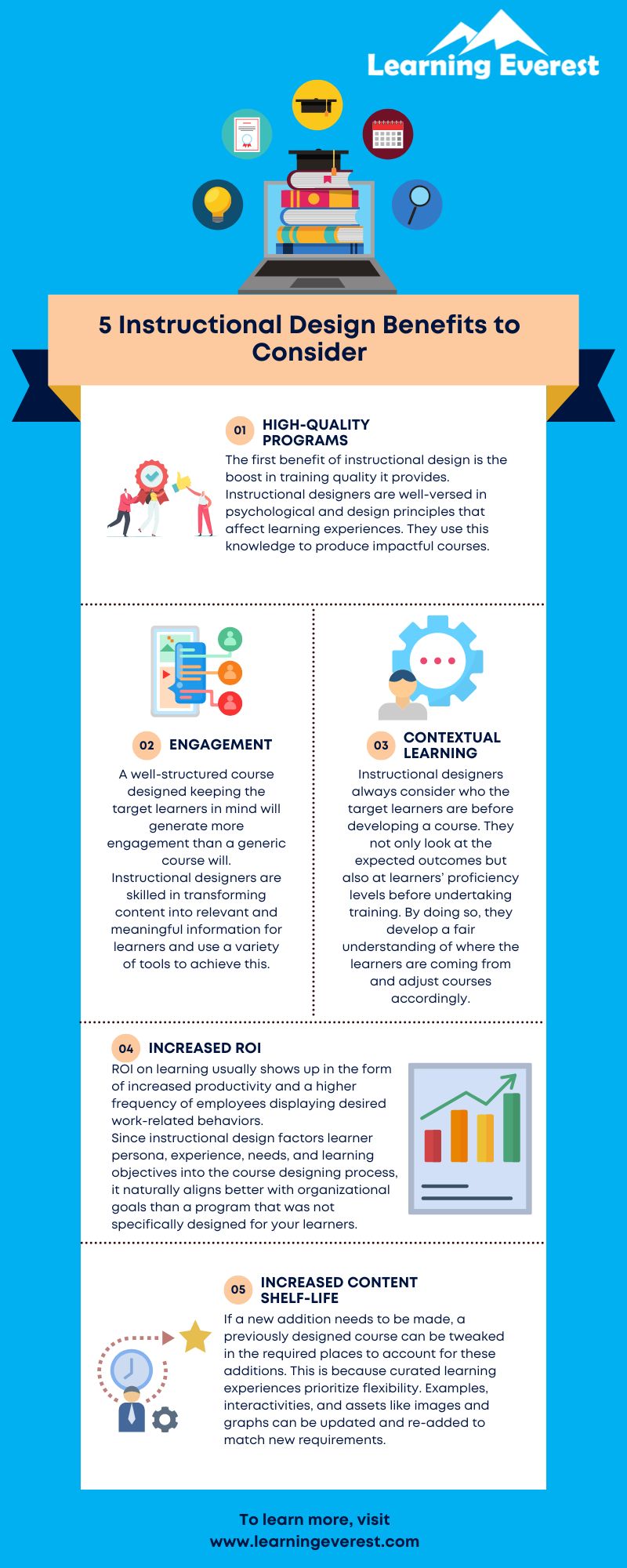Instructional designing is the process of creating learning experiences that fulfill learning objectives and are pleasant and enjoyable for learners. It deals with structuring information in logical ways, applying learning theories and principles for maximum effectiveness, and presenting information in a way that appeals to learners. Instructional design is an essential step in building effective training programs and without it, training efforts will fall flat. Here are 5 instructional design benefits to highlight just how important curated learning experiences are.
Table of Contents
- Instructional Design Benefits #1: High-Quality Programs
- Instructional Design Benefits #2: Learning Becomes More Engaging
- Instructional Design Benefits #3: Learning Becomes Contextual
- Instructional Design Benefits #4: Instructional Design Increases ROI
- Instructional Design Benefits #5: Instructional Designing Increases Content’s Shelf-Life
- Infographic
- Conclusion
Instructional Design Benefits #1: High-Quality Programs
The first benefit of instructional design is the boost in training quality it provides. Instructional designers are well-versed in psychological and design principles that affect learning experiences. Some of the primary ways in which instructional designers achieve high-quality training programs are:
- The utilization of models like ADDIE and Bloom’s taxonomy to structure courses
- Application of color psychology and design principles such as Gestalt to establish an appealing look and feel for the course
- Adding elements of interactivity to the learning process to engage learners. Such interactivities need to be carefully planned out so their placement and frequency produce an impact in the learners’ minds
Instructional Design Benefits #2: Learning Becomes More Engaging
A well-structured course designed keeping the target learners in mind will generate more engagement than a generic course will.
The reason behind this is simple. Adult learners want learning to feel relevant and worthwhile. They can judge for themselves when learning something fits their larger goals and when it doesn’t. Similarly, they can also tell when learning materials are presented in a way that works for them or not.
Instructional designers are skilled in transforming content into relevant and meaningful information for learners and use a variety of tools to achieve this. Some examples are pictures, icons, relevant examples, stories, etc.
By using these strategies, they can develop courses that learners can identify with and find value in. Thus, they become more engaged in the learning process, ultimately making the program more effective.
Instructional Design Benefits #3: Learning Becomes Contextual
Instructional designers always consider who the target learners are before developing a course. They not only look at the expected outcomes but also at learners’ proficiency levels before undertaking training.
By doing so, they develop a fair understanding of where the learners are coming from and can adjust courses accordingly.
In this way, learners get learning that more closely fits their knowledge base and even banks on it. Courses can give learners extra context or more enriching examples if they are new to a topic. Conversely, courses can introduce more advanced elements or skip time-consuming explanations if learners are already very familiar with what they are learning.
Instructional Design Benefits #4: Instructional Design Increases ROI
ROI on learning usually shows up in the form of increased productivity and a higher frequency of employees displaying desired work-related behaviors.
Since instructional design factors learner persona, experience, needs, and learning objectives into the course designing process, it naturally aligns better with organizational goals than a program that was not specifically designed for your learners.
When learners get highly relevant training, they perform better once they have gained the necessary skills. This, in turn, leads to organizational development and growth.
Thus, by opting for custom instructional designing, you will get a greater return on investment for your training efforts as compared to more generic training programs.
Instructional Design Benefits #5: Instructional Designing Increases Content’s Shelf-Life
When learning materials are structured within a framework, it becomes easier to incorporate updates and changes into them.
If a new addition needs to be made, a previously designed course can be tweaked in the required places to account for these additions. This is because curated learning experiences prioritize flexibility. Examples, interactivities, and assets like images and graphs can be updated and re-added to match new requirements.
Additionally, many of the software programs used to develop e-learning courses also have features that allow for updates.
These factors combined make for an environment that anticipates future change and leaves room for it in the design and storyboarding stages itself.
Furthermore, instructional designers also have a good sense for adjusting the rest of the learning experience when changes do arise, eliminating the need for developing sections or courses from scratch.
Another way instructional design increases content shelf-life is by using templates. What templates do is offer pre-existing guidelines and formats for presenting different kinds of information within a course. Thus, instructional designers rarely have to come up with a whole new outline for additions or omissions.
Infographic

5 Instructional Design Benefits to Consider – Infographic
Conclusion
While some businesses might find it more convenient to purchase pre-made courses or find that the expense on custom instructional designing is not justified, ID does offer L&D departments an edge in their training efforts. As is evident from the points highlighted above, instructional design benefits not only affect learners but the organization’s growth, profits, and operations, as well.





